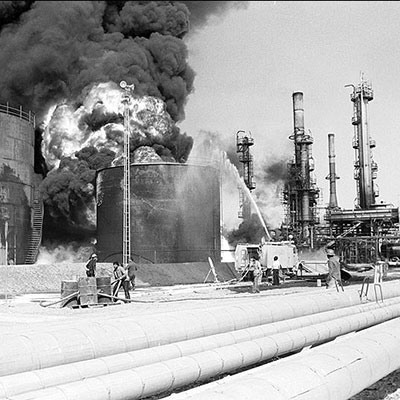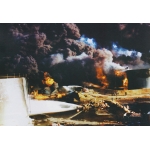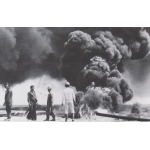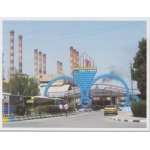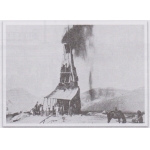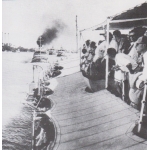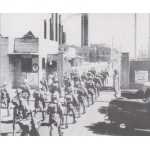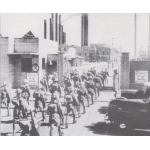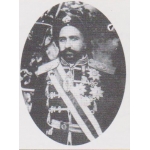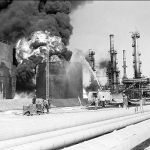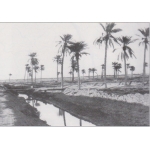The Abadan Refinery
Insiehsadat Mirbabai
569 بازدید
Founded in 1912, the Abadan Refinery is the largest oil refinery in Iran. During the Iraq-imposed war against Iran, it suffered significant damage. However, with the end of the war, many destroyed parts were rebuilt, without the use of foreign labor, by the second half of 1988.
The Abadan Refinery was established in 1908 following the discovery of oil by the British in southern Iran. Andrew Campbell, then CEO of the Burma Oil Company in India, was tasked with selecting a location for the refinery. He decided to construct it in Bowardeh, Abadan, next to Arvandroud. Sheikh Khazal, the then ruler of Khorramshahr, had already provided the required land to the Iran-British company in 1909 with a 99-year lease.[1]
The refinery began operations in 1912 with a daily capacity of 2,500 barrels of oil, exporting its first production to England.[2] During World War I (circa 1914) this refinery was an important source of fuel for war operations. This resulted in the British further developing it.[3] In 1939, during World War II, the Abadan Refinery became well-known throughout the world due to it being able to produce 25,000 barrels of gasoline per day for Allied armies’ warplanes.[4]
After the nationalization of the oil industry in 1950 and the departure of the British in 1951, the refinery's maintenance was entrusted to its employees. [5] In 1972 the Iran Oil Company assumed control of the refinery, and Dr. Reza Fallah became its first Iranian president..[6]
During the height of the Islamic Revolution in November 1978, the workers of the Abadan refinery also joined the nationwide oil industry strike. This caused the production of the refinery to fall from 600,000 barrels per day to 150,000 barrels.[7] However, due to a fuel shortage in the country, the union of the oil industry workers decided to withdraw from the strike at several refineries, including the Abadan refinery.[8] The nationwide strike ended on 18 February 1979, by order of Imam Khomeini.[9]
With the start of the Iraq-imposed war against Iran on September 21, 1980, the operations of the refinery was disrupted and its workforce was evacuated. As a result, support headquarters, including the central headquarters of the refinery, the electricity headquarters (supplying electricity to Khuzestan), the fuel headquarters (supplying gasoline to war machines and storage of fuel in safe places), engineering headquarters (construction of circular bunkers, folding stretchers, wharf and barrel bridges), refinery repair headquarters (multiple repairs of Haft Station Bridge as the only exit to transport the wounded, martyrs and fighters off Abadan Island), the transportation headquarters (transportation and repairs of the units involved in the war), the telecommunications headquarters (providing telecommunications needs) and the logistics headquarters were formed in locations related to the oil industry.
Initially, the employees emptied all the devices of oil materials and took over the protection of the refinery themselves. The warehouses of the refinery facilities were also emptied and the goods were moved to Mahshahr and Aghajari. This process took nine months.[10]
On the first day of the war, the refinery and its gates (except gate number 18) were completely closed, forcing it to shut down.[11]
The Abadan Refinery was the first Iranian oil facility targeted by Iraqi artillery. This occured at 11:00 on October 2, 1980. This resulted in the destruction of about a quarter of its facilities.[12] The fire caused by the oil materials (bitumen barrels), caused severe air pollution in the city, a problem that persisted for several months.[13]
Throughout the war, the Abadan Refinery served as a logistics and support fortress for the southern front of Khuzestan.[14]
The Abadan Refinery faced the most Iraqi attacks, with 23 units, including the distillation unit, drinking water treatment plant, wharf, pump house, and others, completely destroyed.[15]
During the war, Mansour Rahnoord, Mohammad Paknia, Hossein Ali Mesimer and Hassan Drees were responsible for managing the refinery.[16]
From the beginning of the imposed war until the last Iraqi attack on June 10, 1988, 292 employees of the Abadan Refinery were martyred.[17]
Many destroyed units were rebuilt in the second half of 1988 without foreign assistance.. The refinery’s development plan included three phases: the first phase (distillation unit 85) was opened by Ayatollah Khamenei on April 2, 1989 and produces liquefied gas, gasoline and kerosene. The second phase focused on improving product quality, while the third phase involved building the CAT Cracker complex and renovating the acid unit.[18]
The Abadan Refinery, zone 3, was built in 2006 with the aim of producing Euro 4 and Euro 5 gasoline and other oil derivatives. It became operational in 2011 with a capacity of 45,000 barrels of oil per day.[19]
Today, this refinery produces products such as liquefied gas, motor gasoline, kerosene, jet fuel, sulfur, fuel oil, and more.[20]
[1] Javaherizadeh, M, Abadan Refinery in 80 years of Iran's history, Tehran: Shadgan Publishing, 2016, pp. 23 and 24.
[2] Lehsaizadeh, A. A., Sociology of Abadan, Tehran: Kian Mehr, 2006, pp. 169-173.
[3] Javaherizadeh, M., Abadan Refinery in 80 years of Iran's history, p.
[4] Abadan in War, Tehran: Islamic Revolutionary Guard Corps War Studies and Research Center, 2003, p. 22.
[5] Javaherizadeh, M., Abadan Refinery in 80 years of Iran's history, p. 68
[6] Mousavi, S. A., Abadan History, vol.3, Tehran: Shamim Yas Velayat, 2013, p.591.
[7] Javaherizadeh, M., Abadan Refinery in 80 years of Iran's history, pp. 101 and 102.
[8] Taib, S., From the strike of the oil industry workers to the victory of the Islamic Revolution, Tehran: Islamic Revolution Records Center, 2012, p.83.
[9] Pages from the contemporary history of Iran, Iran's Freedom Movement, Volume 9: Third
[10] Mousavi, S.A., History of Abadan, vol.3, pp. 490-492.
[11] Javaherizadeh, M., Abadan Refinery in 80 years of Iran's history, p. 138.
[12] Mousavi, S.A., Abadan History, Vol. 4, Tehran: Shamim Yas Velayat, 2013, p. 154.
[13] Ibid, p. 131.
[14] Ibid, p. 154.
[15] Mousavi, S.A., History of Abadan, vol.3, p.710
[16] Ibid, p. 497.
[17] Ibid, pp. 710 and 711.
[18] Javaherizadeh, M., Abadan Refinery in 80 years of Iran's history, pp. 131-166.
[19] Ibid, p. 202.
[20] Abadan in war, p. 22.


